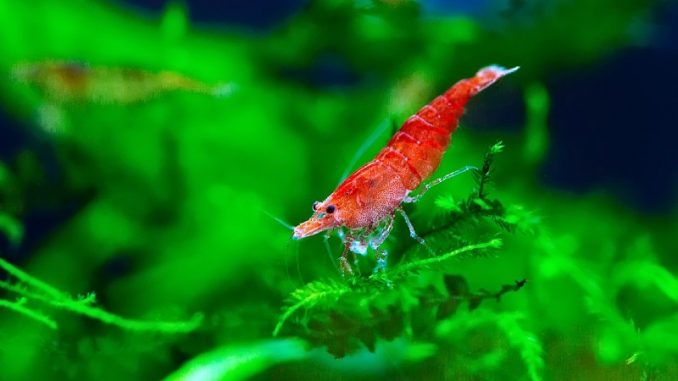
The bright red fire shrimp is a popular species for the home fish-keeping enthusiast. This little fish is also known as a cleaner fish, not because it is any cleaner than any of the other fish, but because it actually cleans other fish.
With its striking red coloring, it is sometimes called the Red Fire Shrimp, Cherry Red Shrimp, Blood Red Shrimp, or Scarlet Cleaner Shrimp. All of these names are an indication for us of just how striking its color actually is.
In this article, we will provide you with all of the important information that you will need to know when caring for the Fire Shrimp.
TABLE OF CONTENTS
Fire Shrimp Facts & Overview
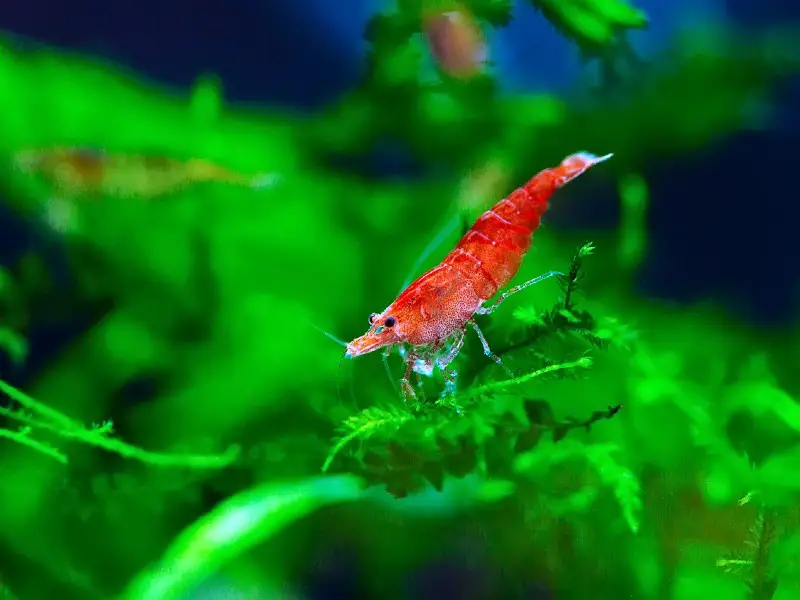
| Category | Rating |
| Care Level: | Easy |
| Temperament: | Peaceful to mildly aggressive |
| Color: | Bright red to deep scarlet, with white spots |
| Lifespan: | Up to 2 years |
| Size: | 1.5-2 inches |
| Diet: | Omnivore |
| Family: | Hippolytidae |
| Minimum Tank Size: | 30 gallons |
| Tank Setup: | Saltwater |
| Compatibility: | Most other small, peaceful saltwater fish |
The scientific name of the Fire Shrimp is Lysmata debelius. It is also known by many other names, all associated with the color red.
This is because its flaming red color is such a magnificent feature that it is usually the first thing that one notices when seeing this fish in an aquarium.
The Fire Shrimp is sometimes called cleaner fish, because of its habit of cleaning other small fish in the tank. Using its antennae, it senses when other fish are nearby, and signals for them to approach. It will then proceed to clean the other fish.
The Fire Shrimp is a saltwater fish, native to the coral reefs of the South Pacific and the Indian Ocean. It is typically found at a depth of about 20 – 30 meters.
This fish is not a difficult fish to maintain, making it a popular choice for the home aquarium. It is readily available in most aquarium supply stores and will cost anything from $20 – $30.
These fish are not known for longevity, with the average lifespan being only about 2 years, or possibly a little longer.
Typical Behavior
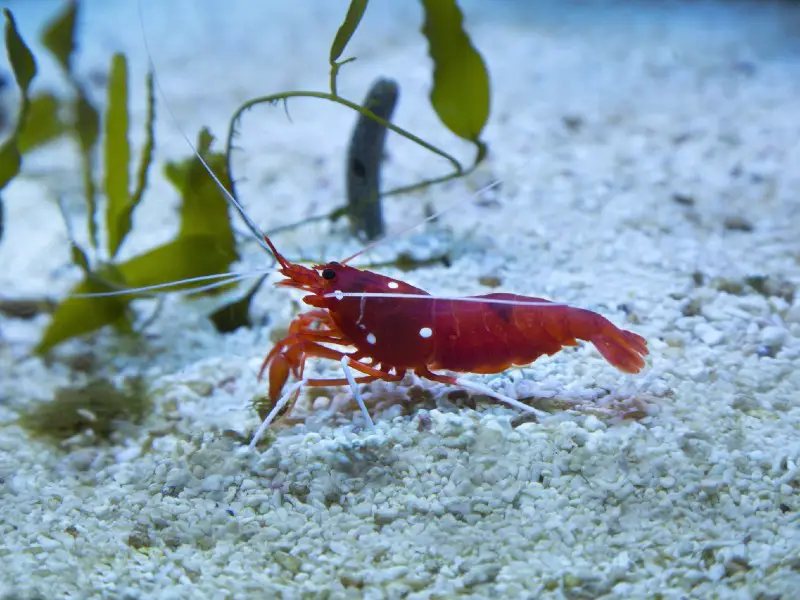
The Fire Shrimp is a quiet and calm fish, with nocturnal behavior habits. It tends to hide away during the daytime, keeping to itself behind rocks, plants, and any other item it can find where it can conceal itself.
They will usually emerge at night when they tend to venture out to search for food. It is possible to train them to recognize your feeding signs so that they will emerge even during daylight hours if they sense that you are there to offer a tasty meal.
If you place food in the tank during the day, they may also come out of their hiding places to eat. But they do not rely on you alone for all of their nutritional needs.
The Fire Shrimp is known as a cleaner fish because it cleans the other fish in its immediate surroundings. Using its antennae to attract other fish, it will clean off dead scales and excess skin from them, and eat it.
They will often keep to one small area of their tank, doing all their cleaning work in this space. Other fish will be drawn towards them. There is a mutually beneficial relationship between the Fire Shrimp and his tank mates.
These fish will approach the Fire Shrimp because they know instinctively that the Fire Shrimp will help them to remove their dead scales and dead skin. They also remove other ectoparasites from the fish and eat them.
If they are frequently offered large amounts of food, they may become less likely to undertake their cleaning duties, as they will not need the nourishment that they gain from cleaning other fish.
The Fire Shrimp will usually be quite happy if he has a fellow Fire Shrimp as a tank mate. However, if there are too many in a tank that is too small, it may feel threatened and will turn aggressive towards others of the same species.
This is why it is often unfairly labeled as an aggressive species. This is not true. The Fire Shrimp will live quite harmoniously with other fish of a similar size, that also has a peaceful temperament.
If you have coral in your aquarium, your Fire Shrimp may display aggressive tendencies towards the coral and will try to eat it.
The Fire Shrimp is known to be quite a lazy fish. It is not very active and is happy to spend its time either in hiding, or swimming very slowly and lethargically around its tank.
The Fire Shrimp has the ability to shed its exoskeleton and grow a new one. You may see the exoskeleton in the tank, and wonder if your Fire Shrimp is dead. It isn’t! It is most probably swimming around happily or hiding under a rock.
The Fire Shrimp that looks to you as if it is dead is nothing more than an empty shell. This fish sheds its exoskeleton, in much the same way that many thick-furred animals molt and shed their outer layer of fur.
Your Fire Shrimp will have already started to grow a new, healthy exoskeleton underneath the old one, and it will eat the one that it has shed. This exoskeleton is rich in minerals and nutrients and provides excellent nourishment for your Fire Shrimp.
Appearance
The beautiful Fire Shrimp is a small fish, growing to an average of 2 inches in length. It is usually a bright red color but is also often found in deeper shades of scarlet.
It has white dots, sometimes all over its body, and sometimes only on its head. The white dots give it an interesting appearance.
The Fire Shrimp has two long antennae that stick out above its head, almost like certain insects do. These antennas are highly sensitive to any vibrations or movement in the water.
The antennae enable it to sense when other fish are nearby so that it can prepare to go into cleaning mode and get ready to start cleaning. After all, it is also known as the cleaner fish.
In addition to its antennae, the Fire Shrimp also has long legs, giving it an unusual and very distinctive appearance.
Habitat And Tank Conditions
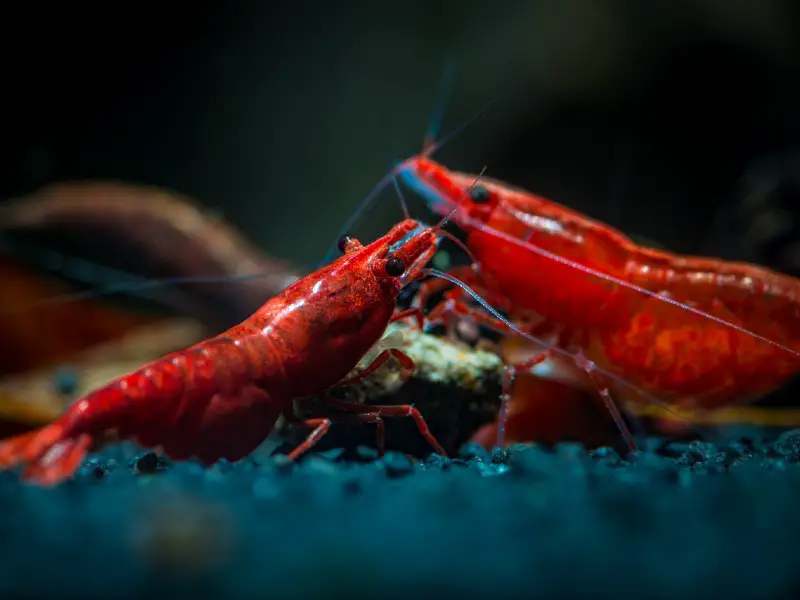
The Fire Shrimp needs a tank set-up that mimics its natural environment as closely as possible. It likes to take cover during the day, so it needs places to hide away.
The Aquarium should have a lot of rocks, logs, plants, and other things with little crevices, where your Fire Shrimp can easily slip out of sight and remain concealed for most of the day.
While coral is a very pretty addition to a home aquarium, some experts say that it is not a good idea to include any type of coral in your tank if you keep a Fire Shrimp.
As mentioned previously, Fire Shrimps like to eat coral. While they won’t rely on the coral for all of their nutritional needs, they will nibble away at it slowly, but steadily, eventually doing a lot of damage to the coral.
The Fire Shrimp does not like bright light and will find places to escape when the light is too bright during the day. It will emerge at night when the light is dim.
This species is very sensitive to the levels of nitrates, copper, and ammonia in the water. These levels should be monitored regularly, and adjusted when necessary.
If there is a sudden drop or spike in nitrate, copper, and ammonia levels, it will have a severely adverse effect on your Fire Shrimp, possibly even killing it.
These fish are not terribly fussy about the hardness or softness of the water in their tank and will be fine whether the water is hard or soft.
They do not like very cold water. They are used to conditions with mild water temperatures. They need an aquarium with a water temperature of between 70° – 78° Fahrenheit. If you are unsure about the water temperature, it is better to lean towards warmer, rather than colder.
It is helpful to have a thermometer to guide you and give an accurate temperature reading. If necessary, depending on outside factors, you may need to buy a water heater to raise the temperature of the water in your aquarium.
The Fire Shrimp does not like extremes in the pH level of the water in its tank. If it is either too acidic or too alkaline, it will not do well. A neutral pH level of between 7.0 – 7.5 is recommended.
The salinity level should be tested regularly, using a salinity refractometer. The SG (Specific Gravity, which measures the salt level in the water) should be maintained at between 1.023 – 1.025. It can be adjusted by using special ocean marine salt.
A very strong current in the water will make it difficult for the Fire Shrimp to hide behind rocks or plants during the bright hours of daylight. Therefore it is advisable to keep the water flow at a low level.
The Fire Shrimp will enjoy an aquarium with a thick substrate. A layer of sand, with lots of plants, rocks, and logs is the ideal environment for this species.
What size aquarium do they need?
The Fire Shrimp is a small fish, so theoretically it should not need too much tank space. However, by its nature, it actually will do far better if it is given a lot more room.
This species is a cleaner fish. It needs space to do its cleaning work on other fish. It is almost as if it likes to create its own workspace, and needs enough room for its cleaning circle.
It will only be able to tolerate other fish of the same species in its tank if there is lots of room for everyone. It can be quite territorial and does not like to share its space.
Therefore, if you have more than one Fire Shrimp, it is advisable to have a fairly large tank. The minimum recommended size is about 30 gallons, but you can go even bigger if you have a few of these fish sharing an aquarium.
Tank Mates
The Fire Shrimp, like all other species of shrimp, is not technically a fish, because it is an invertebrate. It does not have a backbone. It is advisable to think carefully about compatibility when selecting tank mates for your Fire Shrimp.
Some fish-keeping enthusiasts prefer to keep their shrimps and fish in separate tanks. They prefer to have a tank that is occupied exclusively by shrimps. This is a good idea if you have the space for it.
But many people who enjoy keeping fish do not have enough space for separate tanks. Does this mean that you cannot keep a Fire Shrimp in your aquarium?
Not at all! It is definitely possible to keep fish in the same tank as a Fire Shrimp. You will need to select your fish carefully.
The tank mates for a Fire Shrimp should be small fish, no bigger than the Fire Shrimp. He will feel intimidated by anything bigger than himself. They should also be fish with a placid, non-aggressive nature.
Some recommended fish that would make suitable tank mates for the Fire Shrimp are Emerald Dwarf Rasboras and Celestial Danios.
It is often said that you should not have more than one species of shrimp in the same tank. This is not necessarily correct. As long as the tank is big enough, and there are enough places for your Fire Shrimp to hide during the day, it should be fine to introduce other species of shrimp.
A word of caution: the Fire Shrimp should not be paired with other species of shrimp that are bigger than themselves. This will make the Fire Shrimp feel as though he is under attack, and it will provoke an aggressive reaction from him.
Diet
The Fire Shrimp is technically an omnivorous species and will eat anything that it can find. But it has a distinct preference for meat.
Commercial fish food flakes will usually go down well and are a convenient food for your Fire Shrimp. They will also eat pellets and freeze-dried or frozen foods.
This cleaner fish also loves eating the parts of the fish that he cleans off his tank mates. He will remove dead scales and skin from other fish, and eat those. He will also eat his own exoskeleton after he has shed it.
All of these items are rich in calcium and other minerals, which the Fire Shrimp needs in his diet. It helps him to build a strong new exoskeleton after shedding his old one.
Care
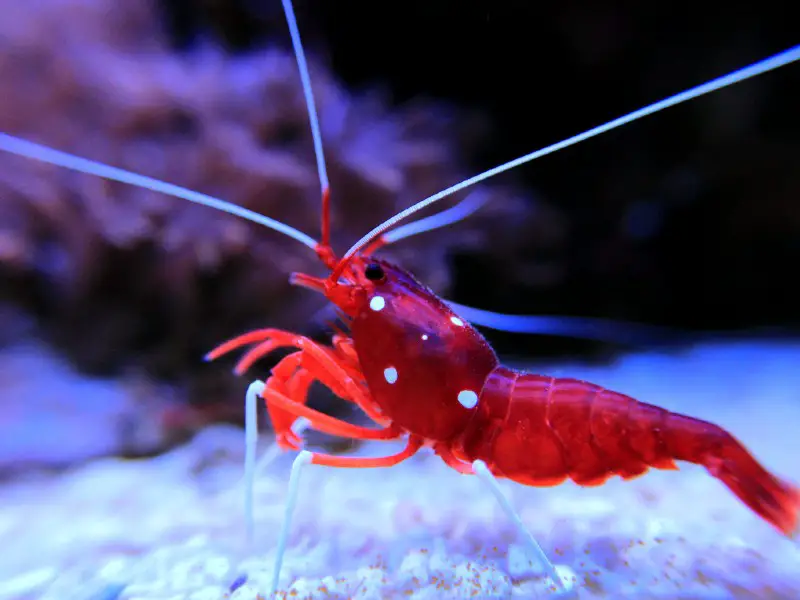
The Fire Shrimp is not a difficult species to care for. It does not have many complicated needs, but there are a few things that do have to be taken into consideration if you are thinking of adding one of these shrimps to your collection.
Setting up the tank for your Fire Shrimp is not complicated. If you take note of the guidelines that have been provided earlier in this article, you should have the perfect conditions for keeping a Fire Shrimp, and your Fire Shrimp should be quite happy in your home aquarium.
The water parameters of its tank are important. It is a good idea to get a water testing kit, in order to be able to monitor the condition of the water accurately. You will find these kits at any good aquarium supplies store.
In order for your Fire Shrimp to thrive, always make sure that the water temperature is at a comfortable level, the pH of the water is neutral, and that the mineral content is well-balanced.
The tank should always be kept clean. It should be free of algae, and the water should be clear and sparkling. One of the best ways to keep the water clear and sparkling is to change it regularly.
While the water does need frequent changing, it is not advisable to change all of the water at once. This will be too drastic a change for your Fire Shrimp, and he may not survive the change to his environment.
He needs to be given the chance to adapt and adjust to the new water. The best way to change the water is to do it gradually, over a period of a few days, rather than in one drastic move.
Start off by removing a small amount of 2-3 liters, and replacing it with clean, fresh water. The following day do the same thing, but you can double the volume of water that you remove and replace.
Follow the same pattern every day for about a week, each day increasing the amount of water that is replaced. Eventually, you will have replaced all of the water in the tank.
Breeding
The Fire Shrimp is a most unusual species when it comes to breeding. You may look at them and wonder how you can tell the difference between the male and the female.
You can’t. And you don’t need to. Because the Fire Shrimp is a hermaphrodite, meaning that it has both the male and female organs that are required for reproduction.
Even if you only have two Fire Shrimps in your tank, you will automatically have what it takes for them to breed. This species breeds well in captivity, as long as its tank conditions are at the optimum, and there is not too much interference from other inhabitants of the aquarium.
The Fire Shrimp will produce between 20 – 30 eggs at a time, and they will take 2 – 3 weeks to hatch. Not all of the eggs will hatch successfully. It is usually a case of the survival of the fittest.
Are Fire Shrimp Suitable For Your Aquarium?
The striking red color of the Fire Shrimp might have aroused your interest, and you may be thinking of adding one to your aquarium.
This is not a straightforward decision, and there are questions that you have to ask yourself.
- Are there other fish in the aquarium that has an aggressive temperament?
- Are there other fish in my aquarium that is significantly bigger than the Fire Shrimp?
- Are there other bigger species of shrimp in my aquarium?
- Is my aquarium on the small side?
If you have answered yes to these questions, then the Fire Shrimp may not be a suitable addition to your home aquarium.
However, if you do have enough space, and you don’t have other big, aggressive fish, and you don’t have other bigger shrimps in your aquarium, these caveats do not apply.
In that case, if you would like the Fire Shrimp to add an interesting facet to your aquarium, there is no reason why you should not be able to keep this species successfully.

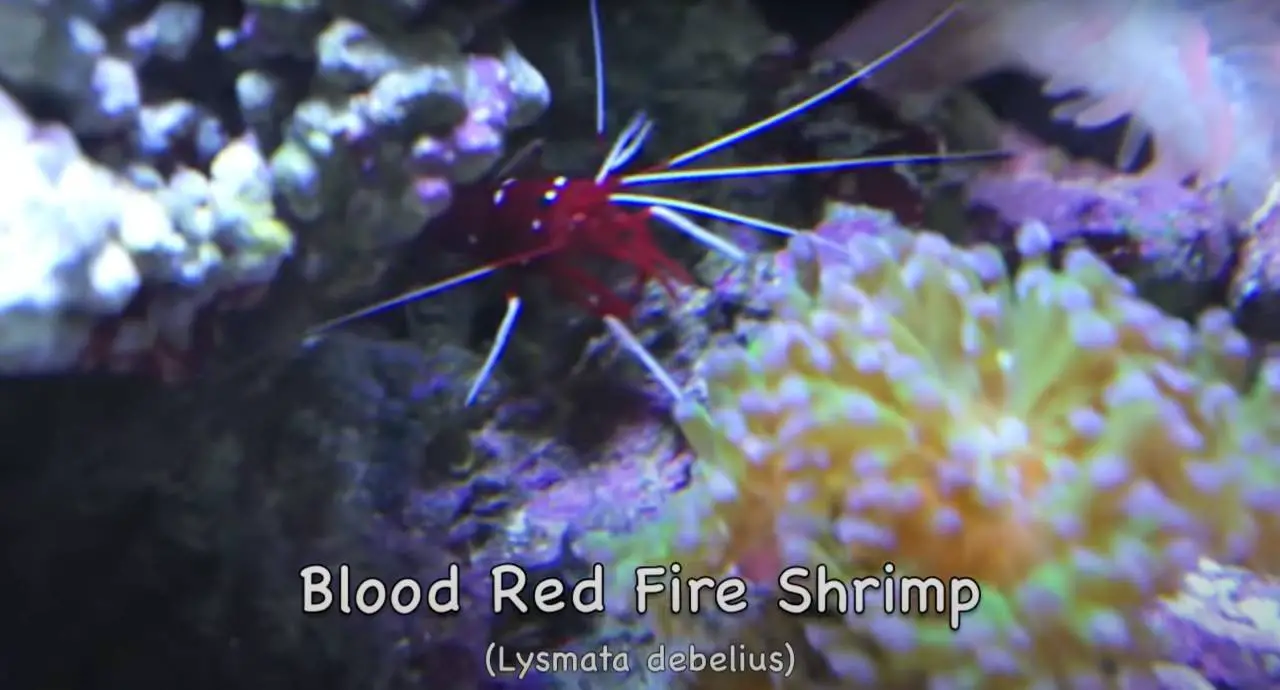
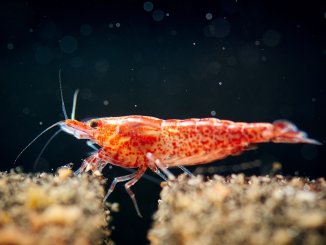
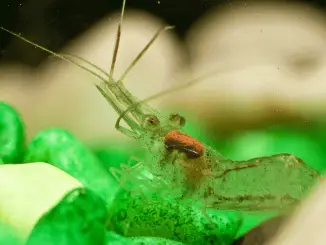


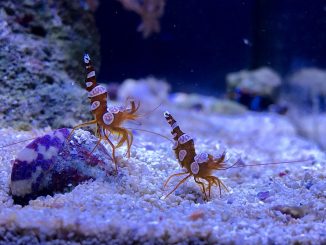
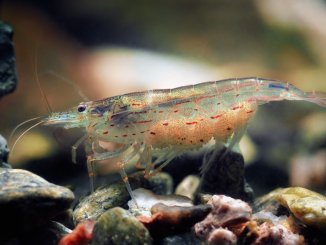
Be the first to comment